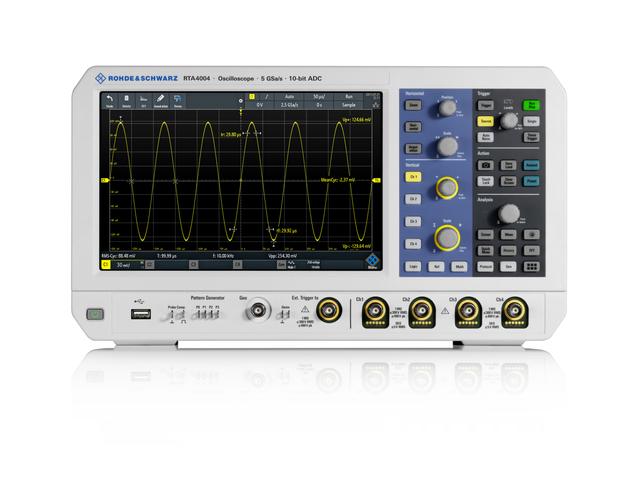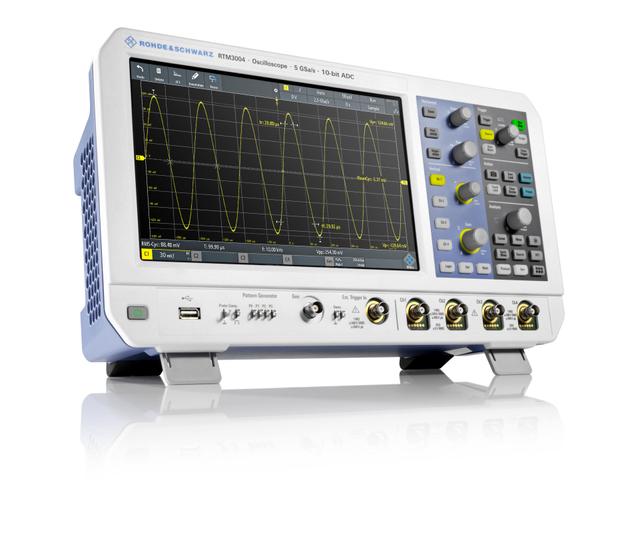Rohde & Schwarz Oscilloscope
Electro Rent partners with Rohde & Schwarz to offer high-quality test and measurement equipment rentals. Designed for testing signals in a variety of applications, these instruments offer quick yet reliable measurements, ideal for solving complex scopes problems and more.
Featured Rohde & Schwarz Oscilloscopes
Frequently Asked Questions
How does an oscilloscope work?
Oscilloscopes are used to measure time-varying signals and display them against a time scale. The amplitude of the signal is measured, in volts, on a y-axis with time against the x-axis. The curve on the screen (representing the signal waveform), shows the changes in the voltage level, with time. These time-varying signals are said to be: “in the time-domain.”
Modern digital oscilloscopes utilize high-speed A/D converters to produce a signal voltage as a series of values called samples. Such digitized waveforms are displayed on a screen that can be analyzed for properties such as amplitude, frequency, rise time, time interval, distortion, and many others.
Oscilloscopes have 2, 4 or 8 channels, each of which can process different signals in parallel. Any signal that can be converted into an electrical voltage representing the current signal strength, such as sound or other vibrations, can also be measured using an oscilloscope.
What is oscilloscope bandwidth?
The bandwidth is the most crucial characteristic of an oscilloscope. Measured in Hertz, it indicates the range of frequencies that the oscilloscope can accurately measure. Technically, the bandwidth of an oscilloscope corresponds to the analog bandwidth of the oscilloscope’s front-end input amplifier which has a low-pass characteristic. Bandwidth is the frequency at which an input signal is attenuated by 3 dB (decibels), corresponding to an amplitude decrease to about 70.7 % of its original value. This means that signals of this frequency or higher, are not accurately measured by the oscilloscope.
How much bandwidth do I need?
- For non-sinusoidal waveforms like e.g., rectangular clock-signals, the oscilloscope bandwidth should be at least 3 times the clock signal fundamental frequency for decoding or debugging and 5 times the clock signal for compliance testing.
- For non-periodic signals, the “rise time” tr, i.e. the fastest / steepest edge of the signal, has to be considered. In this case, the required minimum oscilloscope bandwidth fbw can be approximated using: fbw = 0.5 / tr.
Will I be able to ‘see’ signals above my scope’s bandwidth rating?
Yes! Most scopes can display the signal far beyond the bandwidth rating. Measuring the amplitude accurately will be in question as the scopes input circuitry and A/D converters will limit the accuracy. What is guaranteed, is the scopes 3 dB point of the scope’s measurement capability will be at or beyond the stated bandwidth.
What is the best Rohde & Schwarz entry-level oscilloscope?
This naturally depends on the bandwidth required. The bandwidth specification represents the largest frequency that the scope will accurately measure and display. For entry-level scopes on a budget, where bandwidth is not critical, look at the RTC1000 Series. For general-purpose scopes up to 300 MHz, the RTB2000 is an excellent choice and offers several serial protocol decode options. (See the table below for a comparison.)
What are FFTs and are they any good on scopes?
An FFT is a Fast Fourier Transform and is a mathematical formula to translate a series of samples in the time-domain into the frequency-domain. DSOs have had FFTs for years but have not always performed very well. This is due to a few factors:
- FFTs need a lot of waveform samples to produce frequency-domain results that have significant resolution.
- Older DSOs did not offer a lot of memory and often were limited to just the waveform on the screen.
- Older DSOs had slower CPUs that needed to use CPU power to perform the FFT calculations.
Scopes have come a long way since these limitations and now perform FFTs faster and better than ever before. The Rohde & Schwarz MXO4 and MXO5 for example perform 45,000 FFTs per second and are extremely useful in correlating frequency domain events with regular timing events.
So: can I use a DSO with an FFT to replace a Signal/Spectrum Analyzer?
Well, not really. Signal and Spectrum Analyzers have many advantages over DSOs. Spectrum Analyzers have a much wider dynamic range and can discriminate much smaller signals, which are quite common in RF. They also have useful options like attenuators and pre-amps that make them invaluable tools evaluating frequency-domain signals.
What does mixed-signal mean? Can I use a mixed-signal scope for normal work?
Sure. You can use mixed-signal scopes just like a regular scope. “Mixed-signal” just refers to 8 or 16 extra channels that are digital in nature. MSO scopes still have analog channels just like a DSO scope. Sometimes you’ll see the channel count of a scope as “4+16”, meaning 4 analog plus 16 digital channels. MSO channels only tell you if a signal is above a high or low reference level and represent 0’s and 1’s. Mixed-signal scopes have generally taken the place of logic analyzers in the market today.
What is sample rate and how much do I need?
Sample rate is the number of samples (i.e. discrete values) a digital oscilloscope can acquire per second. The sample rate determines the horizontal resolution of your acquired waveform. Therefore, it defines how many signal details are recorded, i.e. with a small sample rate not all details of a fast-changing signal are measured.
Rohde and Schwarz Scope Series
Here are the Rohde & Schwarz scopes in a very concise table with a few features to highlight some of the basic features. To see all of the Rohde & Schwarz scopes, check the search results <here>
| Series | Bandwidth Models | Channels | Sample Rate Gsamples/s | Max Memory | MSO Ch |
| Scope Rider | 60 MHz to 300 MHz | 2,4 | 5 | 500 kpts | 8 |
| RTC1000 | 50 MHz to 300 MHz | 2 | 2 | 2 Mpts | 8 |
| RTB2000 | 70 MHz to 300 MHz | 2,4 | 2.5 | 20 Mpts | 16 |
| RTM3000 | 100 MHz - 1 GHz | 2,4 | 5 | 80 Mpts | 16 |
| RTA4000 | 200 MHz - 1 GHz | 4 | 5 | 200 Mpts | 16 |
| MXO4 | 200 MHz - 1.5 GHz | 4 | 5 | 800 Mpts | 16 |
| MXO5 | 100 MHz - 2 GHz | 4, 8 | 5 | 1 Gpts | 16 |
| MXO 5C | 100 MHz - 2 GHz | 4,8 | 5 | 1 Gpts | 16 |
| RTO6 | 600 MHz - 6 GHz | 4 | 20 | 2 Gpts | 16 |
| RTP | 4 GHz - 16 GHz | 4 | 40 | 2 Gpts | 16 |








